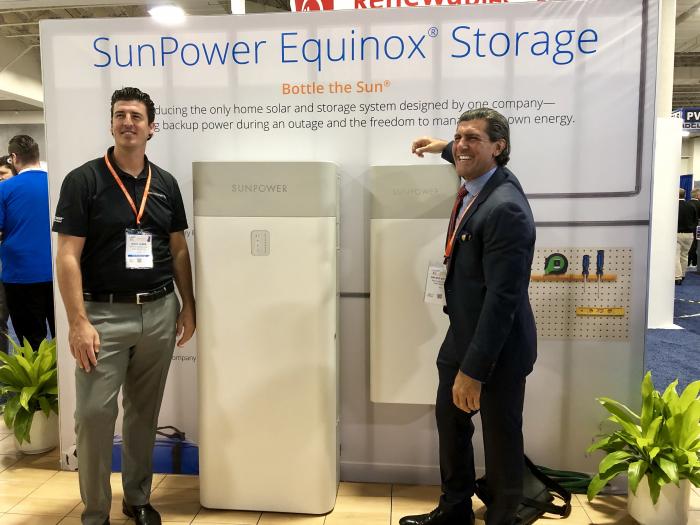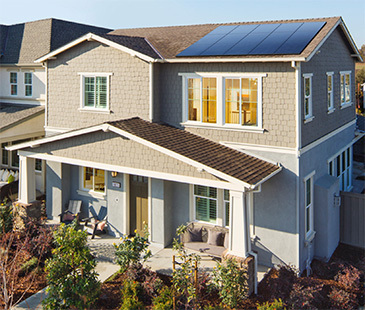
Editors Note: SunPower's SunVault solar storage solution is available nationwide and powers the whole home during an outage. For more information, catch up on one of our latest posts.
This week Californians are enduring the most widespread planned blackouts in the state’s history as utilities began cutting power to hundreds of thousands of people to avoid wildfires.
Flashlight batteries and cases of water are selling out, and gas tanks are being filled as worried residents try to picture their lives in the dark for what could potentially be days.
But there is an alternative. Home and business owners who make their own energy from the sun and store it in a solar battery don’t have to rely solely on an increasingly unstable conventional grid. With a solar battery system, you can store solar energy for use at night, during an outage, or to avoid peak demand charges.
SunPower recently announced Equinox Storage — the first all-in-one residential solar plus storage system designed, engineered and warranted by one company — to provide seamless backup to power essential appliances1 and more.
This means when the grid power goes out, your lights and refrigerator can stay on, and you’ll still be able to charge your cell phone or laptop.*“Essential Appliances” are determined by the homeowner before installation and typically include lights, select appliances and outlets for devices. The battery storage system should not be relied upon as a power source for critical medical devices. The life of the battery storage system will vary depending on a number of factors, including, but not limited to: the amount of energy stored in the battery, the amount of wattage used by the appliances and electronics connected to the battery storage system, the age of the battery, the battery’s ability to recharge during daylight hours due to weather, the frequency and duration of battery usage, and other factors. Battery life will decrease with time and use.
Or, depending upon the size of the battery storage system, your settings and several other factors, you may be able to store enough electricity to power your entire house for a limited period of time.*Your battery storage system’s ability to provide electricity to your home will vary based on a number of factors, including, but not limited to: the amount of energy stored in the battery, the amount of wattage used by appliances and electronics connected to the battery storage system, the age of the battery, the battery’s ability to recharge during daylight hours due to weather, the frequency and duration of battery usage, and other factors. The battery storage system should not be relied upon as a power source for critical medical devices. Battery life will decrease with time and use.
How Equinox home solar battery works in a power outage
The Equinox Storage battery consists of two boxes that are best installed inside a garage, but can be placed outside as well. The main unit, 21 x 62 x 13.5 inches, contains the battery microinverter and either one or two batteries, depending upon your needs, to store up to 13 kWh of energy. For larger homes, multiple units can be connected to reach 26kWh and higher of stored energy.
There is also a small controller box, known as the Hub Plus, which functions as the brains of the system. With the Hub Plus, you don’t have to worry about fumbling around your garage in the dark during a power outage to switch to battery power. The Hub Plus takes care of that for you. The battery storage system connects to (and powers) a set of back-up breakers that are connected to the appliances and outlets that you want to power during an outage.
Since you’ve already chosen which appliances or how much of your house you want to power in a blackout, when the power goes out, the Hub very quickly switches to solar battery power. It’s that simple.
Eligible SunPower Equinox® Solar customers in California can pre-order Equinox Storage beginning in November with installation expected in the first half of next year. In addition to purchasing with cash, qualified customers will be able to finance Equinox Storage with a loan from one of SunPower's lending partners. SunPower expects to expand availability nationwide throughout 2020.
El Cerrito, Ca., solar homeowner Renee Solari, Senior Program Manager for SunPower’s educational services, will be among the first California homeowners to soon have a new Equinox Storage system.
But for now, her family updated their emergency preparedness kit, charged up their solar powered lights and prepped for a campout experience should the power go out.
She said she understands the necessity of planned power outages.
“This is a healthy reality check that makes me appreciate having reliable and abundant power availability,” Solari says. “Given the grid role in recent fires, I don’t think we have a better way to mitigate this risk. We have entered the new normal to manage the climate change impact.”
Commercial customers and governments use solar batteries too
Solar storage isn’t just a concern for homeowners. SunPower was at the forefront of the solar industry when we debuted our Helix® commercial solar storage system in March of 2018.
In Northern California, where on Wednesday PG&E began cutting power to nearly 800,000 customers, SunPower recently announced a solar plus storage project in Contra Costa County.
Contra Costa County recently selected SunPower to install a mix of Helix Roof and Carport solar systems at 10 locations totaling 3.7 megawatts. The project is expected to offset approximately 68 percent grid electricity and save $16.5 million in energy costs over 25 years. Three of those sites will also feature Helix Storage systems that generate a combined 1.5 megawatts (3,000 kilowatt hours) and deliver significant demand charge savings to Contra Costa County.
"The electric utility system is evolving, and we're confident that these solar and storage solutions from SunPower will help us adapt, reducing greenhouse gas emissions and improving the local environment while delivering energy and demand charge savings to the County," said Frank Di Massa, Energy Manager at Contra Costa County. “
Tips for preparing home during an energy blackout
Unfortunately, if you’re reading this article today and you don’t yet have a solar plus storage system, you’re probably just worried about getting by in the coming days. Here’s a link to some helpful tips for preparing your home to survive a power outage:
Key tasks include:
Unplug appliances to avoid potentially damage from power surges when the power is restored.
Keep freezers and refrigerators closed. The refrigerator will keep food cold for about four hours. A full freezer will keep the temperature for about 48 hours. Use coolers with ice if necessary. Monitor food temperatures with a thermometer. If it’s higher than 40 degrees, it may not be safe to consume.
Maintain food supplies that do not require refrigeration.
Avoid carbon monoxide poisoning. Generators, camp stoves, or charcoal grills should always be used outdoors and at least 20 feet away from windows. Never use a gas stovetop or oven to heat your home.

